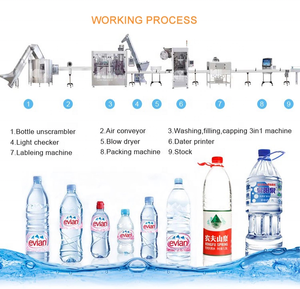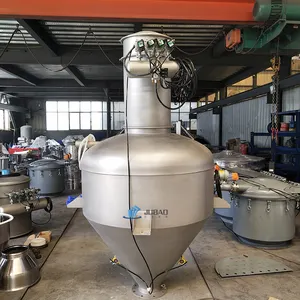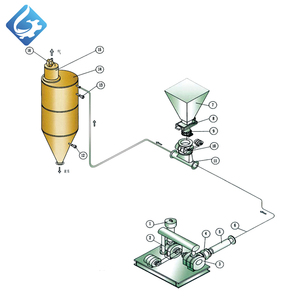
All categories
Featured selections
Trade Assurance
Buyer Central
Help Center
Get the app
Become a supplier

(5119 products available)

































Dense Phase Systems
Dense-phase pneumatic conveyors operate in two-vessel separation, which keeps the conveyor material in motion through slugs or masses. Such systems are ideal for transport of bulky, fragile and aggressive materials envisioned or intended to wear out, such as glass, grains, and plastics.
These systems use a high amount of air pressure to push small amounts of air within a tube. Because the material is transported in dense packets, the system reduces the possibility of material breakdown and ensures that even the most delicate items reach their destination safely. Preferred applications include the moving of heavy powders and granules in limited amounts over long distances.
Dilute Phase Systems
As opposed to dense phase systems, dilute-phase pneumatic conveyor systems transport materials in a continuously reduced stream of air. In these systems, the air is sufficiently raised to place the materials in suspension and carry them through the pipeline.
Dilute-phase conveyors are more flexible when it comes to distance and layout, and they're great for powering lighter materials in substantial quantities. However, materials that are more fragile must be monitored frequently since they may suffer some level of damage in the processing. Common uses include flour, cement and other powdered substances.
Batch Conveyors
Batch pneumatic conveyors are designed to carry Certain amounts of material at one given time. Such systems are primarily used when the transport process requires moving a specific quantity of material from Point A to Point B before the cycle's reset. Such systems enable a high degree of control over the transportation of materials prone to segregation or damage.
Examples of these systems are commonly utilized in such industries as: Food and Beverages, Chemicals, and Pharmaceuticals. The operations of these batch systems must coincide with the overall production process to achieve the desired outcome.
Continuous Conveyors
Continuous pneumatic conveyors move materials non-stop without breaking. These systems are excellent for predictable and steady material flows. They can be designed as either dilute or dense phase, depending on the material to be conveyed and requirements in the process.
These conveyors are favored in industries where constant supply is necessary, such as concrete mixing, glass manufacturing, or the feed in the food industry. The reliability and consistency of continuous conveyors make them a fundamental part of process-based production lines.
Stationary Conveyors
Stationary pneumatic conveyors are fixed in position and used to transport materials from one specific location to another, such as the loading of storage bins or silos. They are designed for long-term operations and are ideal for industries with a steady supply requirement in a particular area.
Such systems can be diluted or have dense phases and are mostly found in industries such as mining, agriculture and power generation. Their design aids in the effective management of storage and the provision of materials for succeeding phases of production.
Food and Beverage Industry
Pneumatic conveyor systems are widely used in the food and beverage industry by virtue of their ability to transport materials that are powdered, granulated or brittle. These systems provide a safe and mechanical means of moving sensitive substances such as grains, sugar, flour and powdered milk. This minimizes physical handling, thus reducing the chances of product contamination and spillage.
Moreover, the systems are also applied in the movement of liquids and semi-solids. In addition, pneumatic conveyors are easy to clean and sanitize; this is particularly very important in the food industry, which must comply with very strict hygiene regulations at all times.
Chemicals and Pharmaceuticals
In the chemical and pharmaceutical sectors, pneumatic conveyor systems transport powders, granules and other bulk materials. Such systems are well suited to these industries since they can handle corrosive substances, toxic materials that may be hazardous to human health. There is little or no compromise on either safety or efficiency.
The enclosed nature of pneumatic conveyors means that there is a general reduction in the dust created within the environment and that there is a lesser risk of chemical exposure. These systems are useful when transporting raw materials needed for drug production or in the chemical plants to ensure constant supply without interruption.
Mining and Bulk Material Handling
Pneumatic Conveying Systems are employed for transporting mineral concentrates, pastes and even dry slurries in the mining sector. They offer a flexible means of transportation over long distances and are highly effective in environments where conventional conveyor belts may not be practical.
They are also ideal for use in remote areas of mining operations, where materials must be transported to processing plants. Furthermore, in industries where the management of the dust and environmental impact is very critical, these systems serve to reduce dust emissions and the resultant spills.
Power Plants
Pneumatic conveyor systems have important applications in power generation plants, particularly in the transportation of coal, ash and other powdered fuels. They are designed to operate with high efficiency and are capable of feeding the furnace with coal while minimizing the emissions of dust and pollutants.
Furthermore, during the transportation of ash, pneumatic conveyors can be used to recycle or dispose of ash, thus integrating within the overall system of the ash management. Their ability to fit into existing plant layouts more easily makes these systems advantageous in upgrading older power plants.
Plastics and Manufacturing
The manufacturing sector employs pneumatic conveyor systems for transporting raw materials such as powders and resins. These systems help in the reduction of manual handling and the associated inefficiencies and increase risks in the operations.
In particular, pneumatic conveyors can be found feeding injection moulding machines with plastic powders, thus ensuring a constant supply. With their flexibility and efficiency, these systems offer an important contribution to the effectiveness and reliability of the plant operations.
Efficiency
In terms of the transportation of bulk materials, pneumatic conveyor systems are required to be very efficient. In comparison with conventional conveying methods, they consume less space and are designed to work over long distances with. They also use less power, hence their cost efficiency and eco-friendliness.
The main advantage of pneumatic systems is that they transport virtually any material, including light and heavy ones, in any shape and form, powders, granules and pellets. This flexibility makes them suitable for several industries, from Food and Chemicals to Mining and Power Plants.
Mechanism of Operation (Moving Parts)
The core constituents of pneumatic conveyor systems are compressors or blowers that create the air required to move the materials. Other parts include pipes or ducts through which materials move, separators for phase distinction, and control systems that regulate pressure, flow, and material transportation.
These components collaborate and are tasked with ensuring the effective and efficient handling of materials in enclosed spaces. Due to the lack of moving elements that need interactions, the systems require minimal maintenance as well.
Durability
The pneumatic conveying systems are designed for longer operating times, and they are harder to put on; thus, they are made and hardened by superior-quality materials such 'steel and aluminum alloys.' Therefore, they can withstand the wear and tear of continuous conveying processes.
With a closed system in which dust emissions are significantly decreased, the overall environmental effect is negated. Further measures in this regard, such as E-filter installation and regular checking of the machinery, also enhance system longevity and decrease the likelihood of breakdown.
Automation Capacities
Pneumatic conveyor systems can be easily integrated with automated controls to regulate the movement of materials. Sensors, flow meters and control panels work together to provide real-time monitoring and adjustment. This integration enhances the responsiveness and accuracy of the systems.
In today's industries, where production demands can change quickly, automated pneumatic conveyors provide the flexibility and control necessary to meet operational needs effectively. Thus, they bring efficiency for greater industrial uses.
The installation of a pneumatic conveyor system demands that a comprehensive assessment be conducted beforehand so as to determine the most appropriate phase and routing of the system. The blowers or compressors need to be located and properly connected to the pipeline, seal all joints to prevent air or material leaks from escaping, and install all necessary controls and sensors.
The system should be easily accessible for all routine maintenance and troubleshooting procedures. In terms of working with dilute phase systems, there is a stronger emphasis on the overall flexibility of the system as it has to conform to different layouts. In contrast, dense-phase systems require greater care in the design to ensure pressure efficiency over longer distances.
Regular checks are mandatory for keycomponents.
The maintenance of pneumatic conveyor systems is crucial to ensure and enhance operational efficiency. In particular, the compressors, seals and control systems demand frequent attention and may require cleaning or lubrication in a compressor's case to avoid any possible over-heating due to the deposit of materials over time or dust.
Also, seals are important in preventing air or material leaks, which can damage or lead to inefficient systems. Furthermore, regular control system inspections mean better dynamic measures, which terminal limit values are required to ensure that the system functions as well as it was designed to.
Regular intern cleaning is important.
In maintaining pneumatic conveyor systems, cleaning the internals of the ducts and pipes is also essential for efficiency. Material build-up can cause blockages and slow the system down or even lead to system errors. Employing E-filters, Proper Dust Collectors or running periodical Checks on the Filters can help eliminate Dust Accretion.
Dust accretion not only leads to inefficiencies but also poses a safety hazard in industrial areas. System breakdowns, for example, can be avoided through cleaning and regular dust management, which can be very costly.
External checks
External inspections of pneumatic conveyor systems focus on the state of the pipes and other visible areas. In this case, it is imperative to check for any damages, such as cracks or wear, which may hinder operation and lack of efficiency.
Maintenance teams need to check for external debris accumulation on the conveyors that can affect functionality. During operation, proper monitoring of dust emissions will eliminate the system's environmental impacts.
Quality of Materials Handled
When selecting a pneumatic conveyor system, one should consider the quality of the conveyed material. Systems must be able to convey materials that are powdery, granular, and fragile, such as those used in food and chemical processing industries. Erosion caused by pneumatic piping or pipeline dust accumulation may affect conveyed material quality.
Moreover, to prevent such interactions with the materials, system components like pipelines and blowers should be manufactured using materials that are resistant to corrosion and have minimal dust generation, for example, stainless steel.
System Leaks
Systemic leakage means the pneumatic conveyor cannot operate effectively. It can further impact product quality since leaks can lead to dust emissions, which, as a result, contaminate products. Spills may occur because of leaks at n junctions or due to worn seals. This affects the material being transported and may cause the equipment to malfunction.
The detection of pneumatic system leaks should be regular. Measures such as periodic seals change as well as constant monitoring contribute to the elimination of air leaks, and thus, efficiency is enhanced.
Fire Hazards
Pneumatic conveyor systems handle a wide variety of materials, some of which can be flammable or potentially hazardous. For example, dust from grains, powders, or other particulate matter can accumulate within the system and create a fire risk if not properly managed.
Therefore, it is important to have adequate grounding of e-statics, which is the reason behind dust collection is employed to filter provisions within the system. Any potential ignition sources, such as electrical components or sparks, should also be minimized to reduce fire risk and ensure safety in systems with flammable materials.
Equipment Malfunction
The pneumatic conveyor system generally experiences mechanical wear and tear, and instance of mechanical malfunction tends to increase. Worn seals or breakables, failures in the compressor and poorinternal dust accumulation tend to lead to system breakdown. Such sudden failures affect productivity and may possibly endanger employees who have to work around faulty mechanization. Regular service and general inspection of the equipment will help to overcome possible instances of malfunction and increase their lifespan.
EMISSION Control
The control of emissions is very important in pneumatic conveyor systems since it relates to both quality and safety considerations. The dust being released from these systems not only deteriorates the air quality, which has health risks such as respiratory problems for employees, but it also affects the environment.
Dust suppression measures such as the implementation of E-filters, Proper Dust Collectors and well-sealed pipelines are vital not only for compliance with environmental standards but also for the protection of workers' health. Systems that manage emissions effectively will promote workers' and facility operators' productivity and safety.
Q1: What is the difference between the dilute phase and dense phase pneumatic conveyor systems?
A1: In the dilute phase, solids are suspended in the airstream, and they are ideal for lighter materials and are used to transport larger quantities over a shorter distance. In contrast, the dense-phase solid material is conveyed in clumps or masses, which is more pressure-intensive and suitable for heavier, fragile materials for transport over longer distances.
Q2: What types of materials can pneumatic conveyor systems handle?
A2: Pneumatic conveyors can transport a wide variety of materials in bulk, including powders, granules, pellets, and seeds. They are commonly used in industries such as food and beverage, pharmaceuticals, chemicals, plastics, and mining. The systems are designed to move dry, free-flowing bulk materials, with adjustments made for specific material characteristics.
Q3: In what applications are batch pneumatic conveyors generally applied?
A3: Batch pneumatic conveyors are particularly useful in food and beverage, pharmaceuticals and chemical industries when high precision transportation of a certain quantity of material from one point to another is required before the material starts to be processed. They are therefore practical in situations where processing requires the material to be in a set amount for a specific duration before moving onto the next stage of production.
Q4: Are pneumatic conveyor systems energy-efficient?
A4: Yes, pneumatic conveyor systems are energy-efficient. They require less space and can transport materials over long distances compared to other conventional methods in terms of efficiency. They can also be very efficient in terms of energy consumption, particularly with advanced compressor designs and automated control systems.